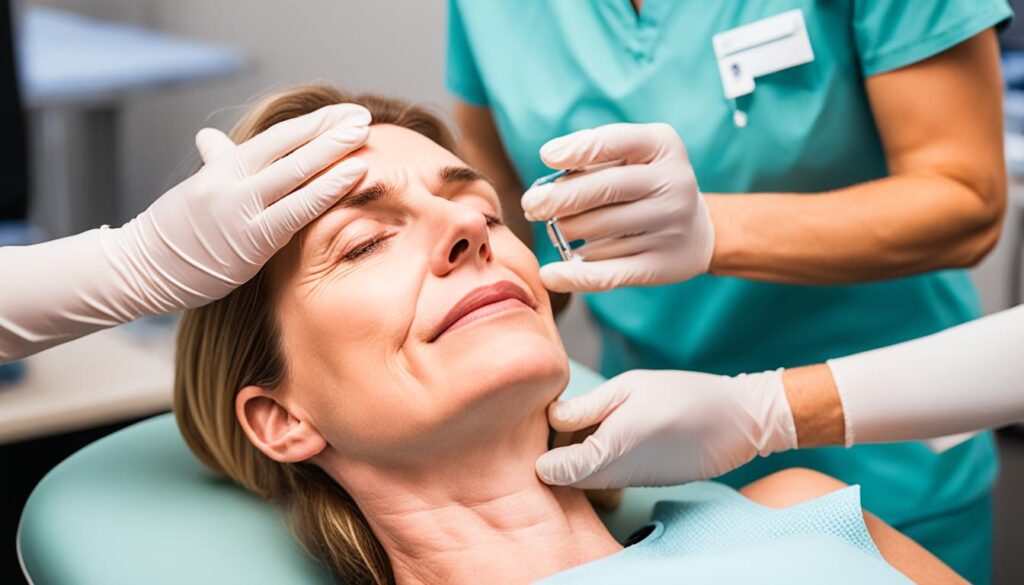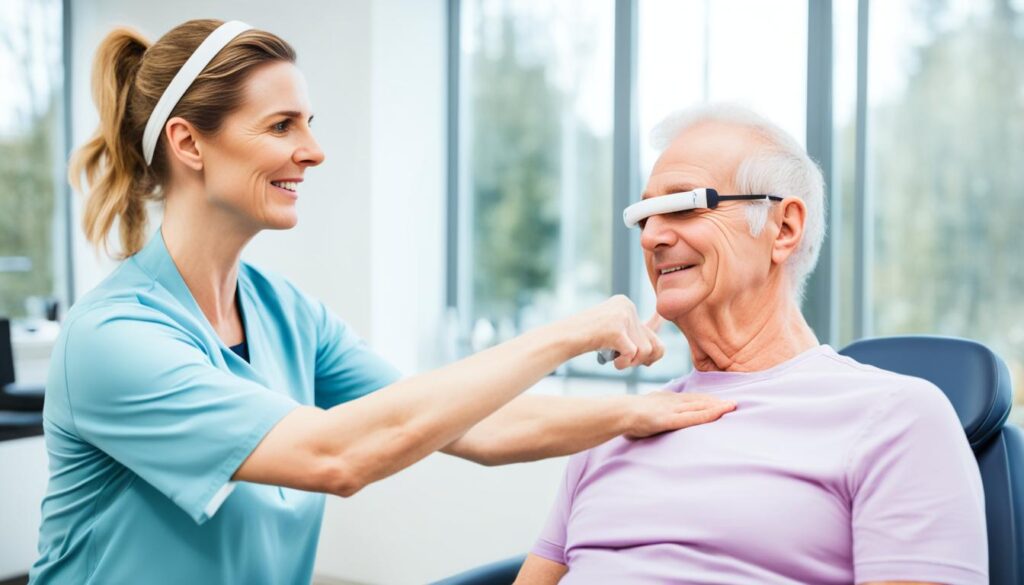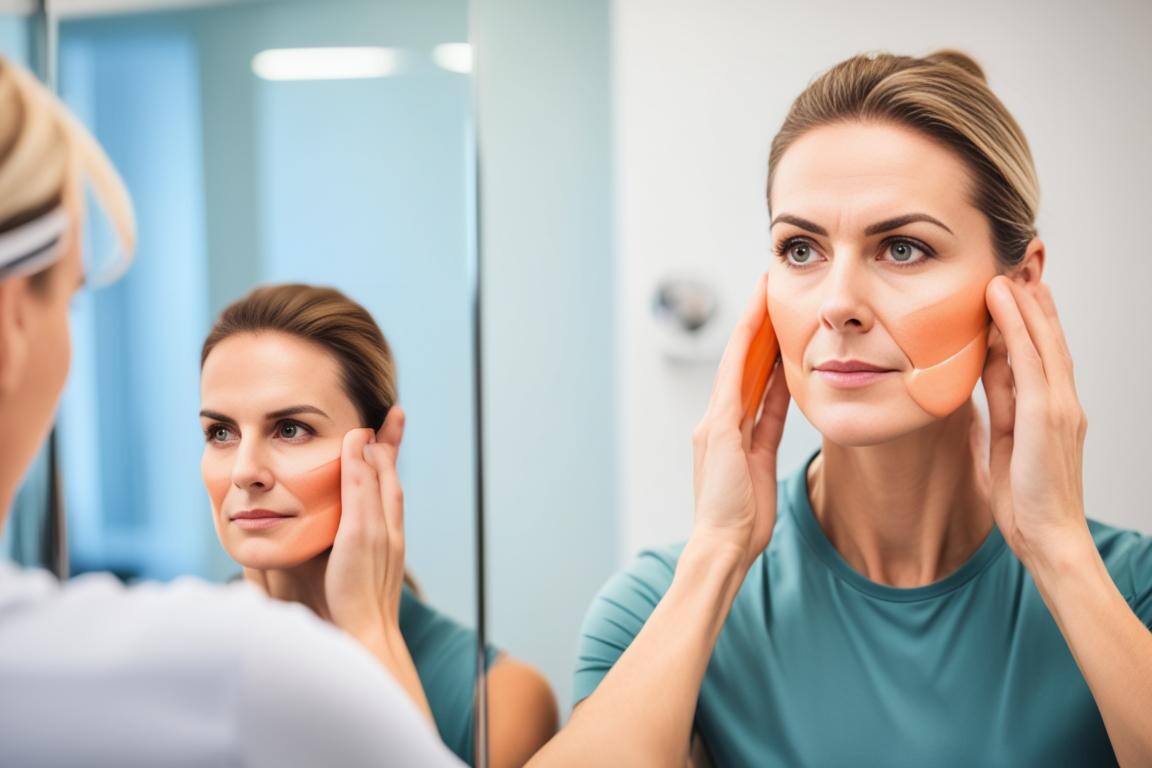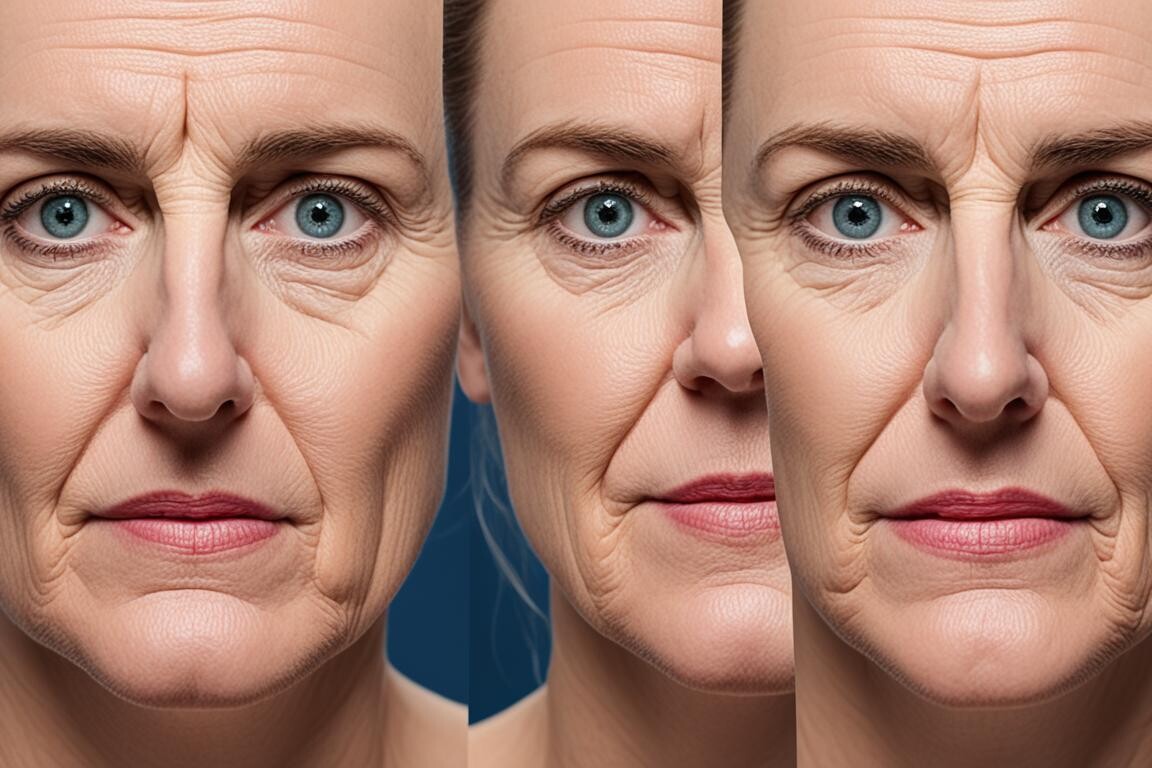Have you suddenly felt one side of your face stop moving?
It’s scary and it can feel like something serious, maybe even a stroke. But what you might be dealing with is Bell’s Palsy.
Every year, more than 1 in 60 people in India experience a similar condition, commonly known as Bell’s Palsy. The good news is with the right care and guidance, recovery is not just possible, it’s likely.
In this article, we will explore the benefits of physical therapy for Bell’s Palsy and provide insights on finding the right physical therapy provider in your area. From understanding the Bell’s Palsy causes to learning about the recovery process, we will guide you through the journey of finding relief and regaining control of your facial muscles.
Key Takeaways:
- Physical therapy can help improve facial muscle strength and mobility in Bell’s Palsy.
- Find a physical therapy provider near you to receive personalized treatment for Bell’s Palsy.
- Understanding the causes and early signs of Bell’s Palsy can aid in early intervention and effective treatment.
- The recovery time for Bell’s Palsy varies, but physical therapy can accelerate the recovery process.
- Eye care and self-help measures are essential in managing Bell’s Palsy at home.
Table of Contents
ToggleWhat is Bell’s Palsy?
Bell’s Palsy is a sudden temporary condition where one side of your face becomes weak or paralyzed. This happens when the facial nerve (cranial nerve VII), which controls your facial muscles, gets inflamed or compressed. The result is half of the face might droop or become stiff.
Many people mistake it for a stroke, but it’s not. Bell’s Palsy usually resolves within weeks to months with the right care.
Bell’s Palsy vs Stroke: What’s the Difference?
| Feature | Bell’s Palsy | Stroke |
| Cause | Facial nerve inflammation | Blockage or bleeding in the brain |
| Onset | Sudden, develops over hours | Sudden, often immediate |
| Facial Weakness | Affects only one side of the face | Can affect face + arm/leg on one side |
| Arm/Leg Weakness | No involvement of arms or legs | Often includes weakness in arms or legs |
| Urgency | Important but not usually life-threatening | Medical emergency—needs immediate attention |
| Treatment Window | Within 72 hours of symptom onset | Immediate treatment (within 4.5 hours for stroke) |
| Prognosis | Most recover fully with therapy | Depends on speed and type of medical response |
Common Symptoms to Watch For
If you’re experiencing any of the following, see a doctor right away:
- Drooping on one side of the face
- Difficulty closing the eye or blinking
- Trouble smiling or lifting eyebrows
- Pain around the jaw or behind the ear
- Increased sensitivity to sound
One-sided facial weakness and eye discomfort are the most common Bell’s Palsy symptoms. Early action helps speed up recovery.
What Causes Bell’s Palsy?
Doctors believe that facial nerve inflammation due to viral infections (like herpes simplex) is the leading cause. Sometimes, stress or exposure to cold wind can trigger it too.
To better understand the causes of Bell’s Palsy, refer to the following table:
| Causes of Bell’s Palsy |
|---|
| Viral infections (e.g., herpes virus) |
| Brain tumors |
| Ear infections |
| Extreme cold exposure |
| Infections like herpes zoster and mumps |
In short, it’s a nerve problem, your facial nerve gets irritated and stops working properly.
Know More → Unveiling Bell’s Palsy Causes – Know the Triggers

Understanding the causes of Bell’s Palsy provides valuable insights into the condition’s underlying mechanisms and helps guide treatment approaches. By addressing the root causes, healthcare professionals can develop personalized treatment plans to alleviate symptoms, promote recovery, and improve the quality of life for individuals affected by Bell’s Palsy.
Treating Bell’s Palsy: Medication and Physiotherapy
The treatment for Bell’s Palsy involves a combination of medication and physiotherapy. Medications are prescribed to reduce inflammation and manage any underlying viral infections that may be causing the condition. Steroids are commonly used to alleviate symptoms and promote recovery.
In addition to medication, physiotherapy plays a crucial role in treating Bell’s Palsy. Physiotherapists employ various techniques to improve muscle strength and coordination, helping patients regain control of their facial muscles and restore normal facial movements.
The physiotherapy treatment plan for Bell’s Palsy may include:
- Facial Massage: Gentle massaging of the facial muscles stimulates blood flow, reduces muscle tension, and helps improve muscle function.
- Exercises: Specific facial exercises are prescribed to strengthen and retrain the affected muscles, aiding in their recovery.
- Acupuncture: The insertion of thin needles into specific points on the face can help stimulate nerve activity and promote muscle healing and restoration.
- Electrical Stimulation: Electrical currents are used to stimulate the facial muscles, enhancing muscle tone and accelerating the recovery process.
Physiotherapy for Bell’s Palsy is tailored to each individual’s needs and may vary in duration. Regular sessions with a qualified physiotherapist are essential to ensure proper technique and progress assessment.
To give you a visual representation, here is a table highlighting the key aspects of medication and physiotherapy in Bell’s Palsy treatment:
| Medication | Physiotherapy |
|---|---|
| Reduces inflammation | Improves muscle strength and coordination |
| Manages underlying viral infections | Restores facial muscle control |
| Promotes symptom relief | Rehabilitates affected muscles |

Recovery Time for Bell’s Palsy
The duration of recovery for Bell’s Palsy can vary from person to person. While some individuals may experience a complete recovery within nine months, others may require a longer period of time. It is important to remember that each case is unique, and the recovery process is influenced by various factors, including the severity of the condition and the individual’s overall health.
Early intervention and appropriate treatment can play a key role in accelerating the recovery process for Bell’s Palsy. Seeking medical attention as soon as symptoms appear and receiving prompt treatment can help mitigate the impact of the condition. Treatment options often include medication to reduce inflammation and physical therapy to enhance facial muscle strength and coordination.
If there is no significant improvement after the initial nine months, it may be necessary to explore further treatment options. In such cases, additional medical interventions, such as surgery or nerve decompression, may be considered in consultation with a healthcare professional.
Factors Influencing Recovery Time
The recovery time for Bell’s Palsy can be influenced by several factors, including:
- The severity of facial muscle weakness
- The underlying cause of Bell’s Palsy
- The individual’s overall health and immune system function
- The effectiveness and consistency of the chosen treatment approach
- The presence of any complications or associated medical conditions
It’s important to remember that each individual’s recovery journey is unique, and patience is essential. With the right treatment and care, the majority of individuals with Bell’s Palsy can expect to experience significant improvement and regain normal facial function over time.

The Role of Physiotherapy in Bell’s Palsy Recovery
Physiotherapy plays a crucial role in the recovery of Bell’s Palsy. It includes exercises and techniques to retrain facial muscles, prevent permanent contractures, and improve muscle tone and coordination. Physiotherapists can provide personalized treatment plans to help you regain facial strength and symmetry and stimulate the facial nerve.

Facial massage is a common technique used in physiotherapy for Bell’s Palsy recovery. This gentle massage helps improve blood flow to the affected area, reducing inflammation and promoting healing. By targeting specific facial muscles and applying therapeutic touch, physiotherapists can help relieve tension and restore muscle function.
In addition to massage, muscle re-education exercises are an essential component of physiotherapy for Bell’s Palsy. These exercises help retrain the facial muscles to regain strength and coordination. By focusing on specific muscle groups and performing controlled movements, you can gradually improve muscle tone and restore natural facial expressions.
Electrical stimulation is another technique often used in physiotherapy for Bell’s Palsy recovery. This therapy involves the use of low-level electrical currents to stimulate the facial nerves and muscles. By delivering gentle electrical impulses, physiotherapists can help activate dormant muscles, improve muscle tone, and enhance muscle re-education.
Benefits of Physiotherapy for Bell’s Palsy Recovery
Physiotherapy offers numerous benefits for individuals recovering from Bell’s Palsy:
- Improved facial strength: Facial exercises and muscle re-education techniques can help strengthen the facial muscles, allowing for better control and coordination.
- Enhanced muscle tone: Through the use of techniques like electrical stimulation, physiotherapy can improve muscle tone and prevent muscle atrophy.
- Restored facial symmetry: Physiotherapy aims to restore balance and symmetry to the face, reducing the visible effects of Bell’s Palsy.
- Increased confidence and self-esteem: By regaining control over facial movements and expressions, physiotherapy can boost confidence and overall well-being.
Incorporating physiotherapy into your Bell’s Palsy recovery plan can significantly aid in the restoration of facial function and improve your quality of life.
| Physiotherapy Techniques for Bell’s Palsy Recovery | Description |
|---|---|
| Facial Massage | A gentle massage technique that improves blood circulation, reduces inflammation, and promotes healing. |
| Muscle Re-education Exercises | Specific exercises that retrain facial muscles to regain strength, coordination, and natural facial movements. |
| Electrical Stimulation | The use of low-level electrical currents to stimulate facial nerves and muscles, improving muscle tone and re-education. |
Self-Help Advice for Managing Bell’s Palsy at Home
While professional treatment is important, there are several self-help measures that you can take at home to manage Bell’s Palsy. These simple practices can complement your recovery journey and improve your overall well-being.
1. Facial Exercises
Practicing facial exercises can help stimulate the paralyzed muscles and improve their strength and mobility. These exercises may include stretching, smiling, puckering your lips, and raising your eyebrows. Performing these exercises regularly can help retrain your facial muscles over time. Consult with a physical therapist or healthcare professional for specific exercises tailored to your condition.
2. Cautious Eating
When experiencing facial paralysis, it’s important to be cautious while eating to prevent choking or injuries. Take smaller bites and chew your food thoroughly before swallowing. Avoid hard or sticky foods that may require excessive effort to chew. If necessary, consult with a speech therapist for guidance on modified swallowing techniques.
3. Eye Care
Bell’s Palsy can affect the ability to fully close one or both eyes, which can lead to dryness and potential damage. Proper eye care is crucial to protect your eyes and maintain their health. Use lubricating eye drops or ointments, wear protective eyewear such as goggles or sunglasses, and consider using an eye patch during sleep to prevent dryness and protect your eye from dust and debris. Regularly consult with an eye doctor to monitor your eye health and receive appropriate care.
4. Stress Management
Managing stress levels can play a significant role in your overall well-being and potentially aid in your Bell’s Palsy recovery. Engage in stress-reducing activities such as meditation, deep breathing exercises, yoga, or engaging in hobbies that bring you joy and relaxation. Taking care of your mental health can positively impact your physical health and aid in your recovery process.
5. Proper Rest and Sleep
Getting adequate rest and quality sleep is essential for your body’s healing and recovery. Make sure to create a comfortable sleep environment, establish a consistent sleep schedule, and practice good sleep hygiene habits. Avoid excessive screen time before bed and create a relaxing bedtime routine to promote better sleep.
Remember, while these self-help measures can be helpful, it’s important to consult with a healthcare professional for guidance and support throughout your Bell’s Palsy journey. They can provide personalized recommendations based on your specific condition and help you make informed decisions for your recovery.

The Symptoms and Early Signs of Bell’s Palsy
Bell’s Palsy is a condition that can cause weakness or paralysis of the facial muscles, usually on one side of the face. Recognizing the symptoms and early signs of Bell’s Palsy is crucial for early intervention and proper treatment. Here are the common symptoms and early indicators to be aware of:
- Inability to close one or both eyes: Bell’s Palsy may affect the ability to fully close the eyelids, resulting in eye dryness and potential damage.
- Difficulty chewing and swallowing: This can occur due to weakness or lack of coordination in the facial muscles responsible for these actions.
- Drooling: Bell’s Palsy may lead to difficulty controlling saliva, resulting in drooling.
- Reduced tear production: The condition can affect tear production, causing dry eyes and a sensation of grittiness.
- Difficulty speaking: Impaired muscle function in the face can impact speech clarity and articulation.
- Pain or ringing in the ears: Some individuals with Bell’s Palsy may experience ear-related symptoms, such as pain or ringing.
Early signs of Bell’s Palsy that may precede the full onset of symptoms include:
- Facial drooping: One side of the face may appear to sag or droop due to muscle weakness.
- Difficulty closing one eye fully: Patients may struggle to completely close one eye, which can lead to eye dryness and potential complications.
- Impaired ability to smile or make facial expressions: Muscle weakness can hinder the ability to smile or express emotions on the affected side of the face.
Recognizing these symptoms and early signs of Bell’s Palsy can help individuals seek medical attention promptly, leading to early intervention and better outcomes. Remember that early diagnosis and appropriate treatment are essential for managing Bell’s Palsy effectively.

Who is at Risk for Bell’s Palsy?
Bell’s Palsy can affect anyone, but some groups are more likely to get it:
- Pregnant women, especially in the third trimester
- People with diabetes
- People with recent upper respiratory infections
- Individuals between 15 to 60 years of age
Men and women are equally affected, but cases spike during winter. Identifying these risk factors early can help prevent delayed treatment.
Can Bell’s Palsy Be Cured? Understanding the Recovery Process
Yes, it can be cured in most cases. But your recovery time can vary depending on how quickly you start treatment and how severe the nerve damage is. Around 85% of patients see full or near-full recovery within 3 to 6 months.
Let’s look at the rough-idea of the expected healing timeline.
| Recovery Stage | Timeframe | What Happens |
| Initial Weakness | 0–7 days | Facial droop appears suddenly |
| Treatment Phase | Week 1–3 | Medication and therapy begin |
| Early Recovery Signs | Week 4–6 | Some movement returns |
| Noticeable Improvement | 2–3 months | Smiling and blinking improve |
| Full Recovery | 3–6 months | Muscle strength usually returns |
Bell’s Palsy recovery time varies, but early support makes a major difference.
Factors That Impact Recovery Speed
Several things affect how fast someone heals:
- Early treatment
- Age (younger people heal faster)
- Severity of nerve damage
- Lifestyle and diet
- Ongoing therapy sessions
Mild cases may heal in weeks. Severe ones might take longer but can still improve with expert help.
Understanding the Effectiveness of Facial Exercises for Bell’s Palsy Recovery
Facial exercises can be a valuable addition to your Bell’s Palsy recovery journey. These exercises are designed to retrain your facial muscles, enhance muscle strength and coordination, and restore natural facial movements. The benefits of incorporating facial exercises into your treatment plan are numerous, as they can help improve facial symmetry, reduce muscle contractures, and enhance overall facial function.
When performed correctly and under the guidance of a physical therapist specialized in treating Bell’s Palsy, facial exercises can have a significant impact on your recovery. A trained professional can assess your condition and tailor a personalized exercise program to address your specific needs and goals.
By engaging in regular facial exercises, you can experience various benefits including:
- Improved Muscle Strength: Facial exercises target the weakened muscles affected by Bell’s Palsy, helping to increase their strength and endurance over time.
- Enhanced Muscle Coordination: By repeatedly performing specific movements, facial exercises can improve the coordination between different facial muscles, allowing for smoother and more coordinated facial expressions.
- Restored Natural Facial Movements: Facial exercises aim to restore the natural movements of your face, helping you regain control over your facial expressions and symmetry.
- Increased Blood Flow: Engaging in facial exercises stimulates blood circulation in the facial muscles, promoting healing and nourishment to the affected areas.
- Boosted Confidence: As your facial strength and coordination improves, you may experience a boost in confidence, as you regain control over your facial expressions and regain your natural appearance.
Also Read → Effective Facial Nerve Paralysis Treatment Options
It is important to note that facial exercises should be practiced consistently and correctly to achieve optimal results. Your physical therapist will guide you through the proper techniques and ensure that you are not exerting excessive strain on your muscles.
In addition to facial exercises, your physical therapist may incorporate other techniques such as mirror therapy, electrical stimulation, and massage to further enhance your recovery. These interventions can complement the benefits of facial exercises and contribute to your overall progress.
Example Facial Exercises for Bell’s Palsy Recovery
| Exercise | Technique |
|---|---|
| Eye Blinking | Closing and opening your affected eye for a set number of repetitions, gradually increasing the speed and intensity. |
| Lip Stretch | Stretching your lips by smiling as wide as possible, holding the position for a few seconds before relaxing. |
| Forehead Wrinkling | Raising your eyebrows as high as possible, wrinkling your forehead, and holding the position for a few seconds before relaxing. |
| Facial Massage | Gently massaging your face in circular motions, focusing on the affected side to stimulate blood circulation. |
Remember to consult with your physical therapist before starting any facial exercises or modifying your current routine. They will provide tailored guidance to ensure that you are performing exercises safely and effectively.
The Importance of Eye Care in Bell’s Palsy Treatment
Bell’s Palsy can have a significant impact on your eyes, affecting your ability to fully close them. This can lead to eye dryness and potential damage if left unmanaged. To prevent eye complications, it is crucial to prioritize proper eye care as part of your Bell’s Palsy treatment.
One of the key measures to safeguard your eyes is the use of lubricating eye drops. These drops can provide much-needed moisture and alleviate dryness. Additionally, eye patches or protective glasses can be utilized to shield your eyes from external elements and reduce the risk of damage.
Consulting an eye doctor is highly recommended for individuals with Bell’s Palsy. They can evaluate the condition of your eyes and provide expert guidance on managing eye care effectively. They may offer tailored recommendations based on your specific needs, ensuring that you adopt appropriate measures to protect your eyes during your Bell’s Palsy treatment.
Remember, maintaining good eye care is paramount in preventing eye complications and promoting overall eye health as you navigate through your Bell’s Palsy recovery journey.
Bonus Read → Effective Bell’s Palsy Eye Treatment Options
Eye Care Measures for Individuals with Bell’s Palsy
| Eye Care measures | Description |
|---|---|
| Use lubricating eye drops | Moisturizes the eyes and helps alleviate dryness. |
| Wear eye patches | Provides protection and prevents foreign particles from entering the eyes. |
| Use protective glasses | Shields the eyes from external elements and reduces the risk of damage. |
| Consult an eye doctor | Ensures proper evaluation of eye condition and personalized eye care recommendations. |
Adopting these eye care measures and seeking professional guidance will help preserve your eye health and minimize the chances of complications during your Bell’s Palsy treatment.
Additional Therapies & Home Remedies to Support Healing
While medical treatment and physiotherapy form the backbone of Bell’s Palsy recovery, you can also benefit from complementary approaches at home.
Safe Complementary Therapies
These methods are often used alongside traditional treatment to enhance recovery:
| Therapy | Potential Benefit |
| Acupuncture | May reduce inflammation and stimulate nerve regeneration |
| Relaxation Techniques | Deep breathing, meditation, or yoga help reduce stress and tension |
| Biofeedback Therapy | Helps patients consciously retrain muscles through visual feedback |
Always discuss these with your doctor before starting.
Simple Home Remedies That Support Recovery
Though not a cure on their own, these gentle remedies can make your recovery journey more comfortable and effective.
Try These At-Home Practices
| Remedy | How It Helps |
| Warm Compress | Relaxes tight muscles and eases pain |
| Gentle Massage | Stimulates circulation and helps reduce facial stiffness |
| Balanced Diet | Nutrients like B12, zinc, and antioxidants support nerve healing |
| Adequate Hydration | Keeps tissues healthy and helps your body recover faster |
When to See a Specialist
If your symptoms persist, worsen, or don’t show signs of improvement within a few weeks, it’s time to consult a specialist. Early intervention can significantly improve recovery outcomes.
See a specialist if you experience:
- No improvement after 3–4 weeks of self-care or physiotherapy
- Severe facial pain or persistent headaches
- Vision problems or inability to fully close the eye
- Drooling or difficulty eating and speaking
- Muscle twitching, spasms, or tightness on the affected side
- Recurring episodes of facial paralysis
- Signs of another neurological issue (e.g., limb weakness, slurred speech)
Recovery is Possible with the Right Guidance
Bell’s Palsy may come without warning, but with timely care, therapy, and expert support, your face can regain full function.
But you don’t have to figure this out alone.
Whether you’re in the early stage or struggling with long-term effects, Dr. Chugh will walk you through what to expect, how to recover, and which therapies will work best for you.
Your recovery starts with the right doctor → Schedule a consultation with Dr. Chandril Chugh today
FAQ
What is Bell’s Palsy?
Bell’s Palsy is a condition that causes temporary paralysis of the muscles in one side of the face due to inflammation of the facial nerve.
What causes Bell’s Palsy?
The exact cause of Bell’s Palsy is unknown, but it is believed to occur due to viral infections, such as the herpes virus, and other factors including brain tumors, ear infections, and extreme cold exposure.
What are the treatment options for Bell’s Palsy?
The treatment for Bell’s Palsy may include medication to reduce inflammation and antivirals if the condition is related to a viral infection. Physiotherapy, such as facial massage, exercises, acupuncture, and electrical stimulation, is also important for improving muscle strength and coordination.
How long does it take to recover from Bell’s Palsy?
The recovery time for Bell’s Palsy varies, with most people making a full recovery within nine months. However, some individuals may take longer. Early intervention and appropriate treatment can help accelerate the recovery process.
What is the role of physiotherapy in Bell’s Palsy recovery?
Physiotherapy plays a crucial role in Bell’s Palsy recovery by retraining facial muscles, preventing permanent contractures, improving muscle tone and coordination, and stimulating the facial nerve. Techniques such as facial massage, muscle re-education exercises, and electrical stimulation may be used.
Are there any self-help measures for managing Bell’s Palsy at home?
Yes, individuals with Bell’s Palsy can practice facial exercises, be cautious while eating, maintain eye care, and manage stress levels at home. However, it is important to consult with a healthcare professional for specific self-help measures.
What are the symptoms and early signs of Bell’s Palsy?
Symptoms of Bell’s Palsy include an inability to close one or both eyes, difficulty chewing and swallowing, drooling, reduced tear production, difficulty speaking, and pain or ringing in the ears. Early signs may include facial drooping and impaired ability to smile or make facial expressions.
Who is at risk for Bell’s Palsy?
Bell’s Palsy can affect anyone, but it is most common in people between the ages of 20 and 40. Individuals with diabetes and pregnant women are at a higher risk, along with those with certain infections and medical conditions.
How effective are facial exercises for Bell’s Palsy recovery?
Facial exercises can be effective in Bell’s Palsy recovery as they help retrain facial muscles, improve strength and coordination, and restore natural facial movements. Working with a physical therapist who specializes in Bell’s Palsy can ensure the exercises are performed correctly and tailored to individual needs.
Why is eye care important in Bell’s Palsy treatment?
Bell’s Palsy can affect the ability to close one or both eyes fully, leading to eye dryness and potential damage. Proper eye care, including the use of lubricating eye drops, eye patches, or protective glasses, is crucial in preventing eye complications.
What are the complementary therapies and home remedies for Bell’s Palsy?
Complementary therapies such as acupuncture and relaxation techniques, along with home remedies like facial massage, heat therapy, and proper nutrition, can complement the treatment plan for Bell’s Palsy. However, it is important to consult with healthcare professionals before trying these methods.
Source Links
About The Author

This article is medically reviewed by Dr. Chandril Chugh, Board-Certified Neurologist, providing expert insights and reliable health information.
Dr. Chandril Chugh is a U.S.-trained neurologist with over a decade of experience. Known for his compassionate care, he specializes in treating neurological conditions such as migraines, epilepsy, and Parkinson’s disease. Dr. Chugh is highly regarded for his patient-centered approach and dedication to providing personalized care.
→ Book a consultation to discover which remedies suit your needs best.




